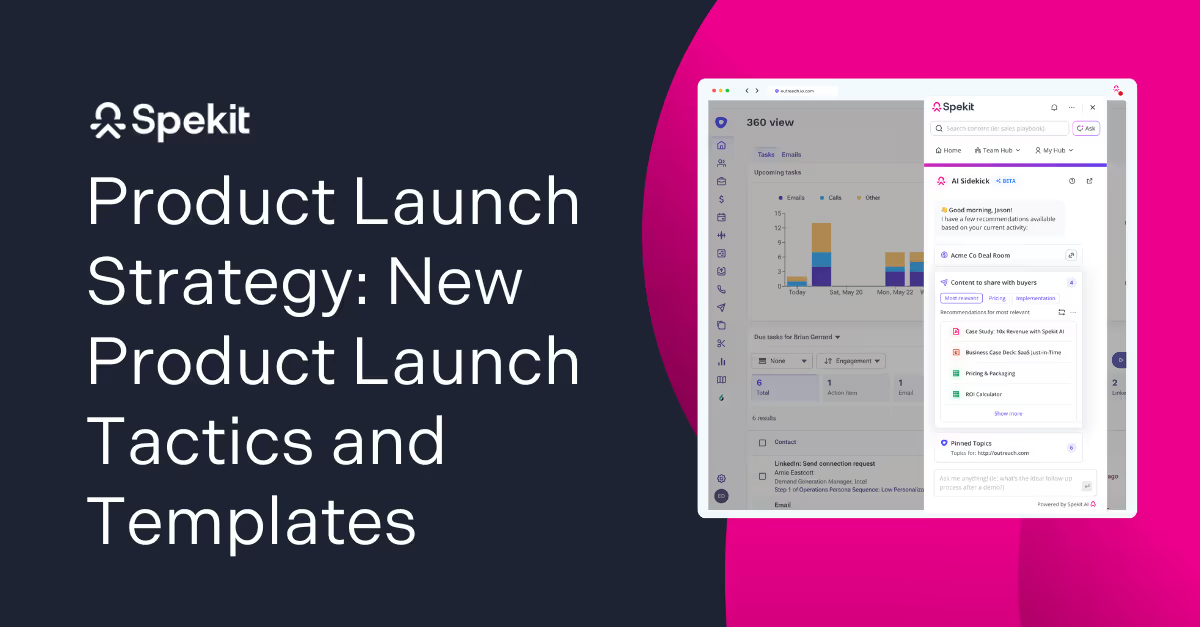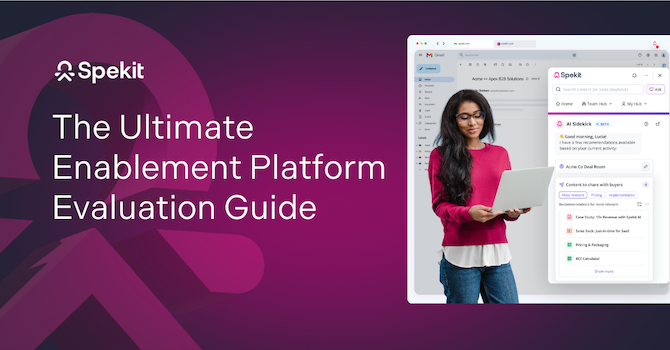Picture this: You just launched a new product. The emails are out, the social posts are live, and the launch plan is running like clockwork.
But within days, reps are pinging you on Slack nonstop:
“Who’s the best fit for this again?”
“How exactly is this different from what we already offer?”
“Do we have a demo flow for this yet?”
And those that haven't pinged you are making it up as they go along.
The product’s out the door, but your sales team is still catching up.
When reps don’t know how to talk about the product, what makes it different from competitors, or how to handle early objections, their conversations with prospects stall and the product launch fails.
This article shows you how to get your sales reps launch-ready.
We cover:
- The building blocks of a product launch sales training strategy
- How to reinforce training after product launch
- How to measure sales readiness for product launches
- And how Spekit helps you reinforce sales training in the flow of work.
The role of sales training in product launch success
Product launch plans typically focus on release dates, marketing campaigns, and feature announcements. But the moment that determines whether a launch is successful happens in a prospect’s inbox, during a cold call, or during a live demo, when a rep has to explain why the product matters.
When sales teams aren’t fully prepared ahead of launch, here’s what tends to happen:
- Mixed messages — prospects get different answers depending on who they talk to.
- Improvised pitches — reps fill in the blanks with their own assumptions.
- Slow traction — deals stall because buyers don’t see the value of the product.
Sales training prevents this by giving every rep a clear, consistent framework: how to talk about the product, who it’s for, what problems it solves, and how to handle common objections.
How Product, Marketing, and Sales work together: Launches and beyond
Effective sales training content isn’t created in isolation. It’s a collaborative effort between Product, Marketing, and Sales.
- The Product (Development) team brings the insight behind each feature—what it does, why it matters, and how it’s used.
- The Product Marketing team translates those insights into clear positioning and messaging that connect with the right buyers.
- The Content team creates campaigns and creative assets (launch emails, social copy, etc.) that drive awareness and generate demand.
- The Sales team contributes frontline input—what buyers are asking, where they’re hesitant, and how competitors are framing the conversation.
When these teams work together, they create training content that is consistent and immediately usable during calls (or demos).
That said, even the best content won’t drive better conversations or close more deals if reps can’t find it when they need it. To be effective, content must be accessible where reps work, easy to revisit, and updated as messaging evolves.
Read: Product Launch Content: Examples & Strategies to Nail a New Product Launch
The essential building blocks of a product launch sales training strategy
An effective product launch sales training strategy equips reps with the right message, tools, and support to confidently engage buyers from day one.
Here are the key components every launch training strategy should include:
- Equipping reps with messaging and positioning
Before launch, your reps need to know how to talk about the product: what it does and how it can help prospects. So, instead of saying the product “saves time,” they’d say something more specific and useful, like how it frees up a full day each month by automating manual reporting.
Here’s how to get them there:
- Create a positioning brief that outlines the target audience, value proposition(s), differentiators, key proof points, and information about competitors.
Product marketing typically owns this but should create it in collaboration with Sales and whoever leads sales readiness, whether that’s a formal Enablement team, a sales manager, or a go-to-market (GTM) lead.
- Repurpose the brief into elevator pitches, battlecards, and product one-pagers that reps can easily use in conversations. Tailor the messaging in these docs for each audience.
- Use role plays to build confidence. Create time in your training calendar for live or asynchronous practice. Let sales reps test the messaging in low-stakes environments and get feedback from peers or managers.
- Document and distribute messaging consistently. Store the messaging doc in a central, accessible location (e.g., a shared Google Doc, Notion, or content management system) so everyone is pulling from the same source.
- Preparing reps for objections and competitive conversations
The first few sales calls after a launch are rarely smooth. Buyers will have questions, and they’ll compare you to competitors. Your reps need to be ready to tackle those questions and objections confidently.
Arm them with:
- Objection-handling guides that include effective rebuttals and how to respond clearly and calmly, without getting defensive. You can get this information from sales leadership and top-performing reps.
- Battlecards that lay out key differences between you and your competitors in plain language, including feature gaps, strengths, and proof points that highlight your advantage. The product marketing team can help with this.
Keep the battlecards short, focused, and easy to skim.
- Create talk tracks that help reps sound confident under pressure, even if they’re still learning the product.
- Take time to pressure-test responses live, ideally with sales managers or top-performing reps playing the buyer role.
- Aligning pricing and packaging with buyer discussions
Pricing and packaging often change with a new product, which can trip up even seasoned reps. If reps aren’t sure what’s included, when to discount, or how to explain ROI, they’ll hesitate—and buyers will, too.
To help them:
- Walk through the pricing logic. Help reps understand not just the numbers, but why the pricing structure looks the way it does. For example, if the product is an email platform and the pricing changes based on the number of contacts a prospect has, explain why.
This context typically comes from the revenue or leadership team, who set pricing strategy based on market positioning and business goals.
- Build "if/then" guides. For example, if a buyer needs X, then recommend Y tier. If they’re working with a small budget, then position Z discount. Give reps decision trees they can follow when speaking with prospects.
- Clarify how this product fits with existing offerings (if any). If the new product is an addition to a larger suite, your reps need to know how it works with existing products. This helps them sell to existing customers.
- Record mock pricing conversations. Let junior reps hear how top sellers handle tough pricing questions or pushback.
- Strengthening demo skills
Demos are often the make-or-break moment in a deal, so reps need to know not just what to click, but what to say.
Here’s what helps:
- Create persona-based demo flows. A finance leader wants business impact. A hands-on user wants ease of use. So, equip reps with tailored demos so they can choose the right one based on who they’re speaking to and what the person cares most about.
- Provide demo talk tracks. These aren’t meant to be word-for-word scripts, but flexible outlines reps can adapt based on who they’re speaking to. A good talk track makes it easy to tie each product feature back to something the buyer actually cares about.
For example, instead of saying, “Here’s our dashboard,” a talk track might prompt: “This dashboard gives your team a real-time view of project delays, so you can spot risks before they become expensive.”
- Practice live. Set up mock demos ahead of launch and have managers or enablement leads sit in. Focus the feedback on clarity, flow, and how well reps connect features to buyer pain points.
- Embedding product knowledge in selling tools
The most important moment to apply sales training is during live conversations with prospects. But if key content (like talk tracks, objection responses, and sales decks) is buried in folders or email threads, reps can’t use it when it counts.
Training content needs to live where reps already work, and that’s exactly what Spekit enables.
With Spekit, you can:
- Surface training content (like talk tracks, battlecards, sales decks, product one-pagers, and even case studies) directly inside tools reps already use (like Salesforce, Gmail, and LinkedIn). This way, they don’t have to dig for info or switch tabs to find what they need.
- Update content instantly. Whether it’s refining a battlecard or tweaking a feature description, edits go live in seconds, so reps always have the most accurate information in front of them.
- Reinforce key concepts with in-the-moment nudges. Spekit delivers timely nudges during discovery calls or demos, like a reminder to mention a key pain point or stat, so reps stay sharp, even under pressure.
- Empowering managers to coach and reinforce training
Training doesn’t end after product launch. If you want reps to remember and apply what they’ve learned, managers have to coach and reinforce training consistently.
Here’s how to empower managers to do that:
- Give them weekly prompts or questions for 1:1s and team meetings. Questions like “How are you positioning the product this week?” or “What objections are you hearing most?” help spark reflection and help reps figure out the best way to answer.
- Equip managers with a simple checklist to assess how reps are positioning the product, handling resistance, and tying features to buyer pain. This keeps feedback focused and tied directly to launch priorities.
- Share visibility into rep readiness. With Spekit, managers can see which reps are engaging with training content and where gaps exist. This helps them coach more effectively and give support where it’s actually needed.
Read: How to Launch a Product
How to reinforce training after launch (when reps need it most)
Training content needs to show up where reps work, stay up to date, and evolve alongside real sales conversations.
Here’s how to make that happen with Spekit:
1. Centralize training content so reps can find it fast.
When training content is scattered across Google Drive, Confluence, Slack, and email, everything slows down. Reps waste time searching for answers, and worse, they risk using outdated or inconsistent messaging. In a product launch (or really, any critical selling moment), that kind of confusion can cost you deals.
Spekit solves this by centralizing all your launch content in one place, including docs, videos, PDFs, slide decks, spreadsheets, and more. You can sync materials from your existing tools or pull from over 1,000 pre-built templates to quickly close gaps.
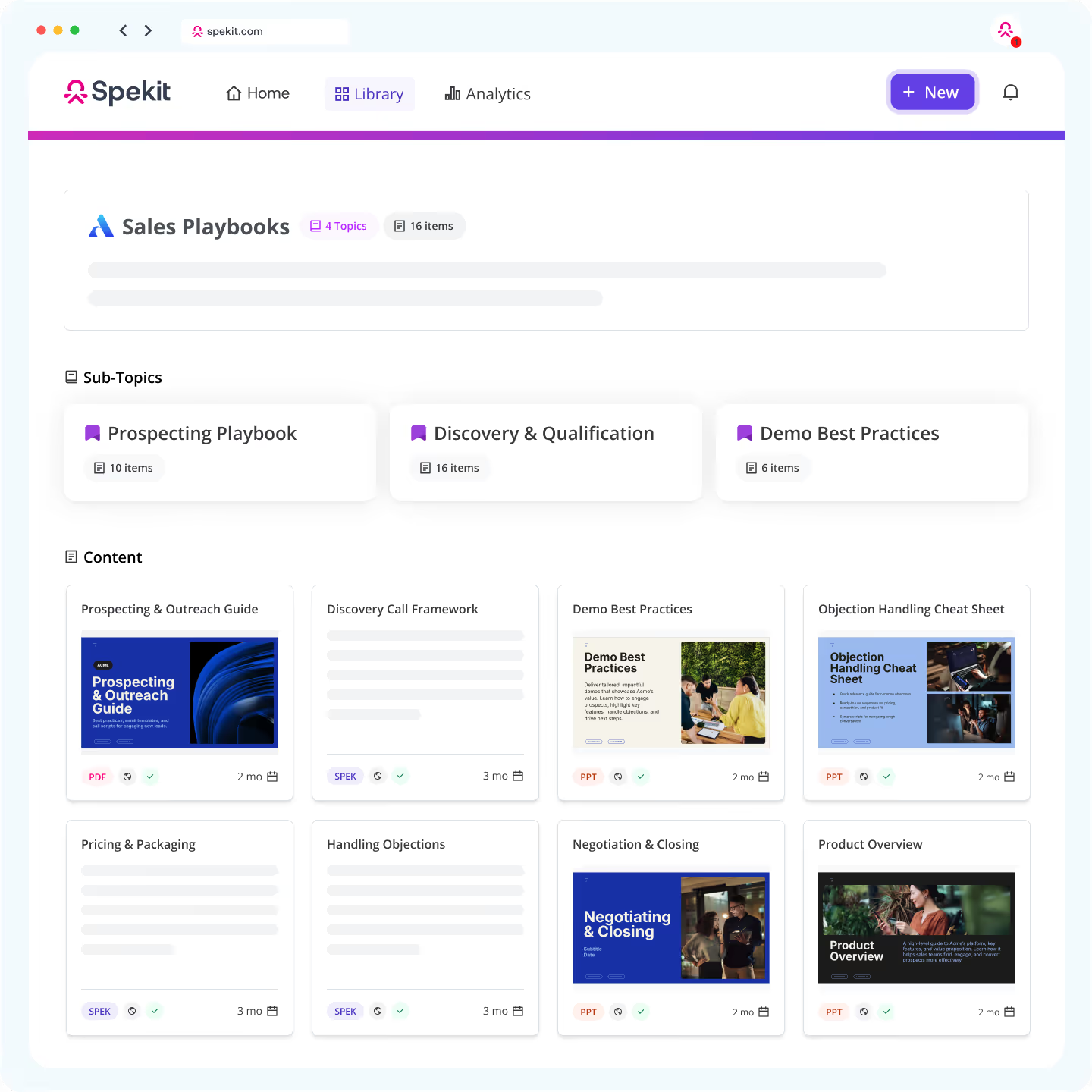
With Spekit AI, you can also turn scattered docs and wikis into structured Playlists for onboarding, product launches, or process rollouts. This way, reps have everything they need in one place, organized by use case.
Read: AI sales enablement: 6 ways AI helps reps close deals faster
2. Just-in-time enablement that happens within sales tools.
Reps can’t afford to pause mid-call or mid-chat to dig through folders or search Slack for a talk track or case study. They need accurate and reliable information as they work.
Spekit AI contextually surfaces training content (like sales decks, battlecards, talk tracks, pricing details, and more) directly within the tools reps already use, including Salesforce, Gmail, LinkedIn, Chrome, and Slack.
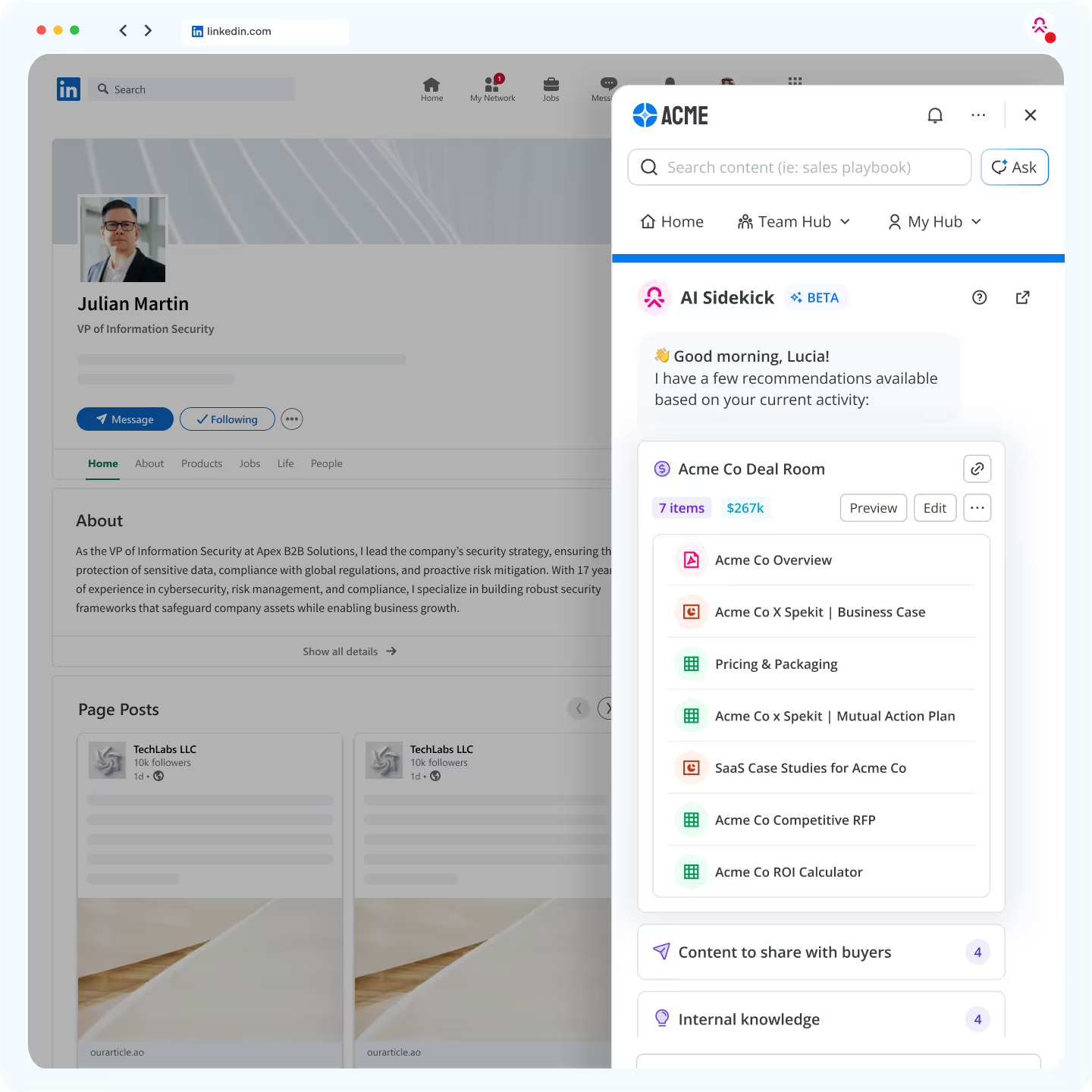
Reps can also ask questions from any app and get instant answers or resources, whether it's a product detail, a one-pager, or guidance on how to position a feature.
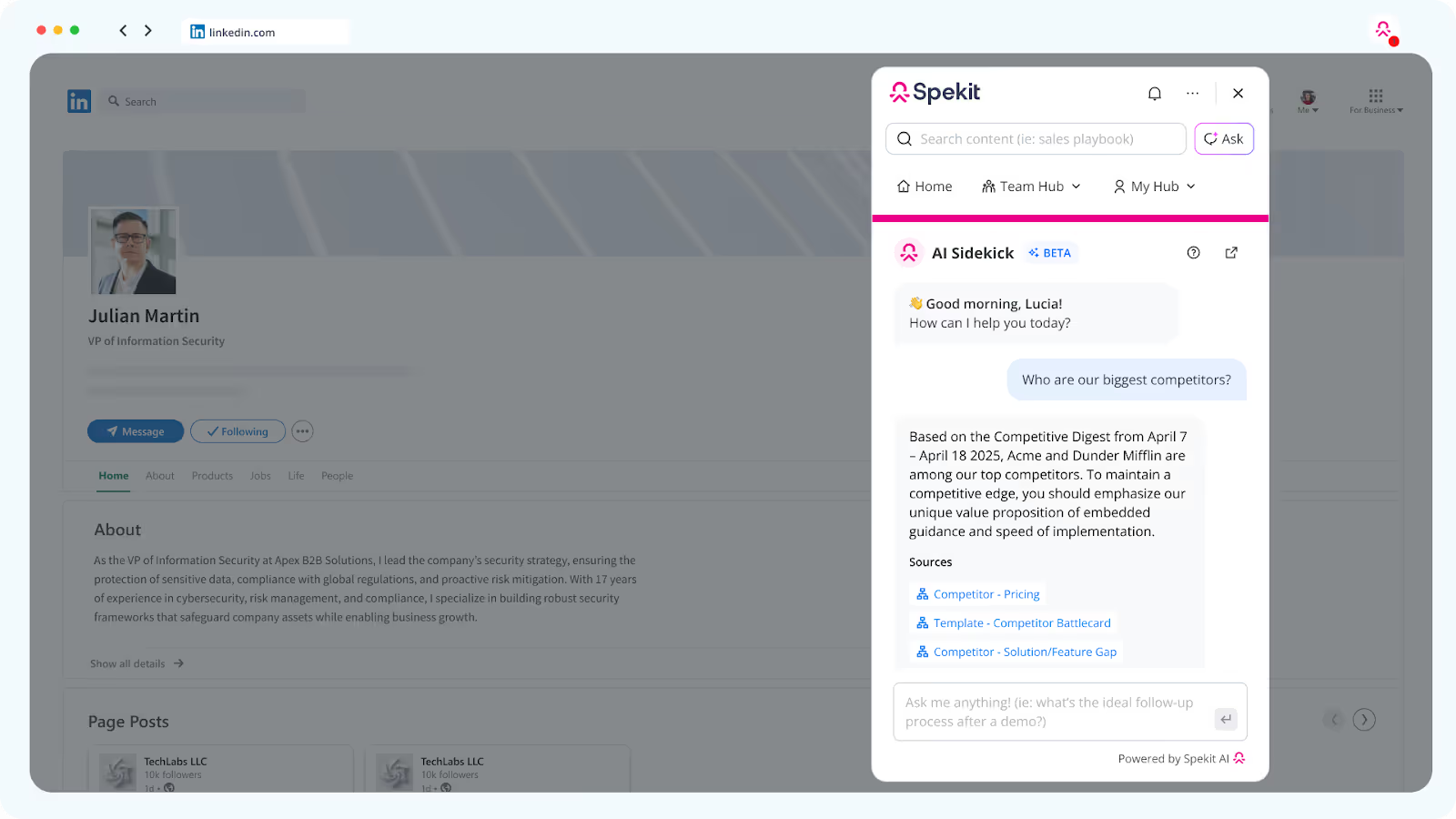
You can take it further by creating bite-sized prompts (called Speks) that guide reps through objection handling, sales stages, and key messaging. They’re easy to understand and built for real-time use.
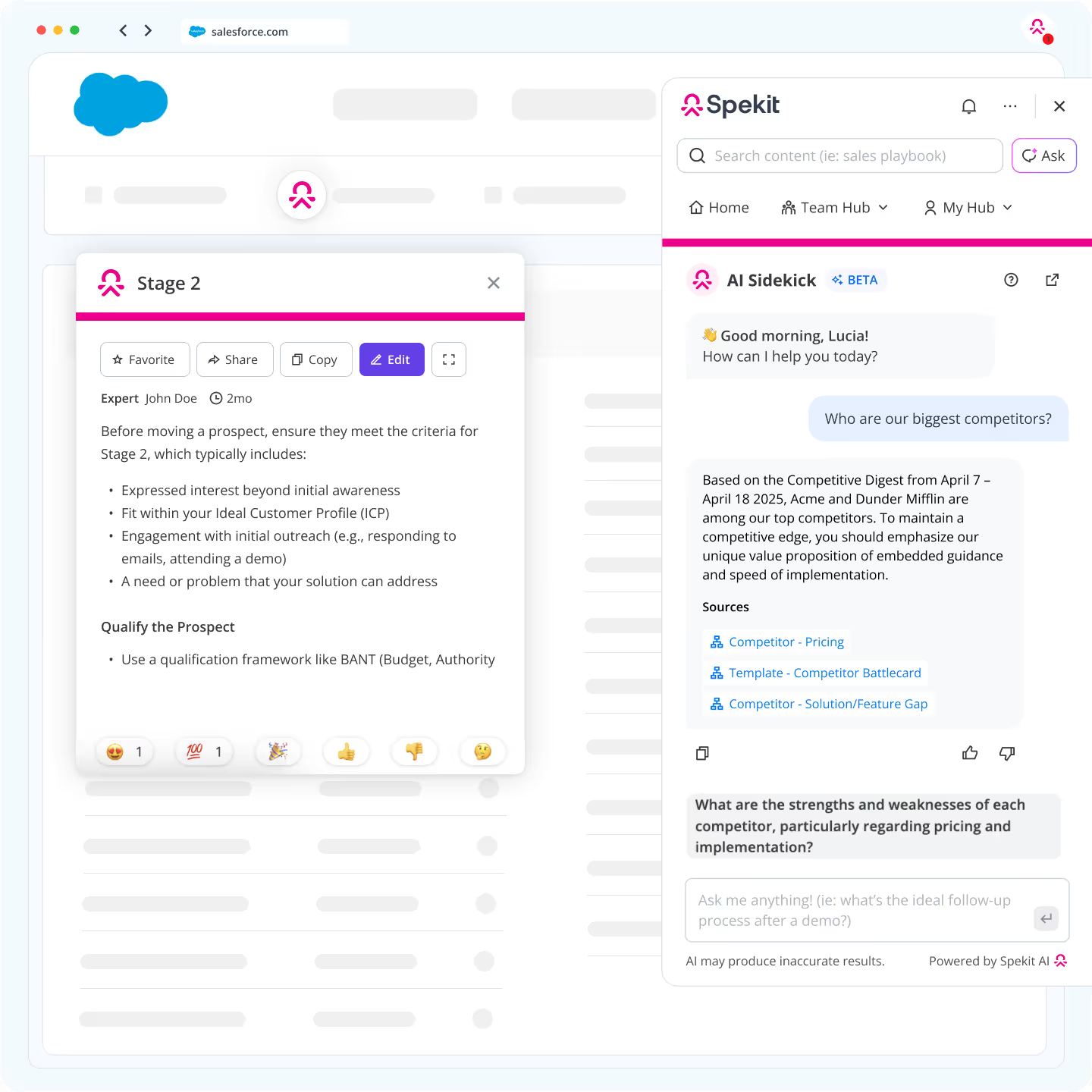
By delivering knowledge in the flow of work, Spekit helps reps stay prepared and better equipped to close deals.
3. Keeping content fresh with real-time updates.
As reps start selling, real-world objections, new buyer questions, and competitor comparisons begin to surface. This means you’ll need to update training content to help reps tackle these issues head-on.
Because Spekit centralizes everything, updating a Spek, battlecard, talk track, or messaging document takes just a few clicks.
Once changes are made or new content is added, Spekit sends targeted, contextual notifications using Spotlights. Reps immediately see what’s new, what’s been updated, and exactly where to find it.
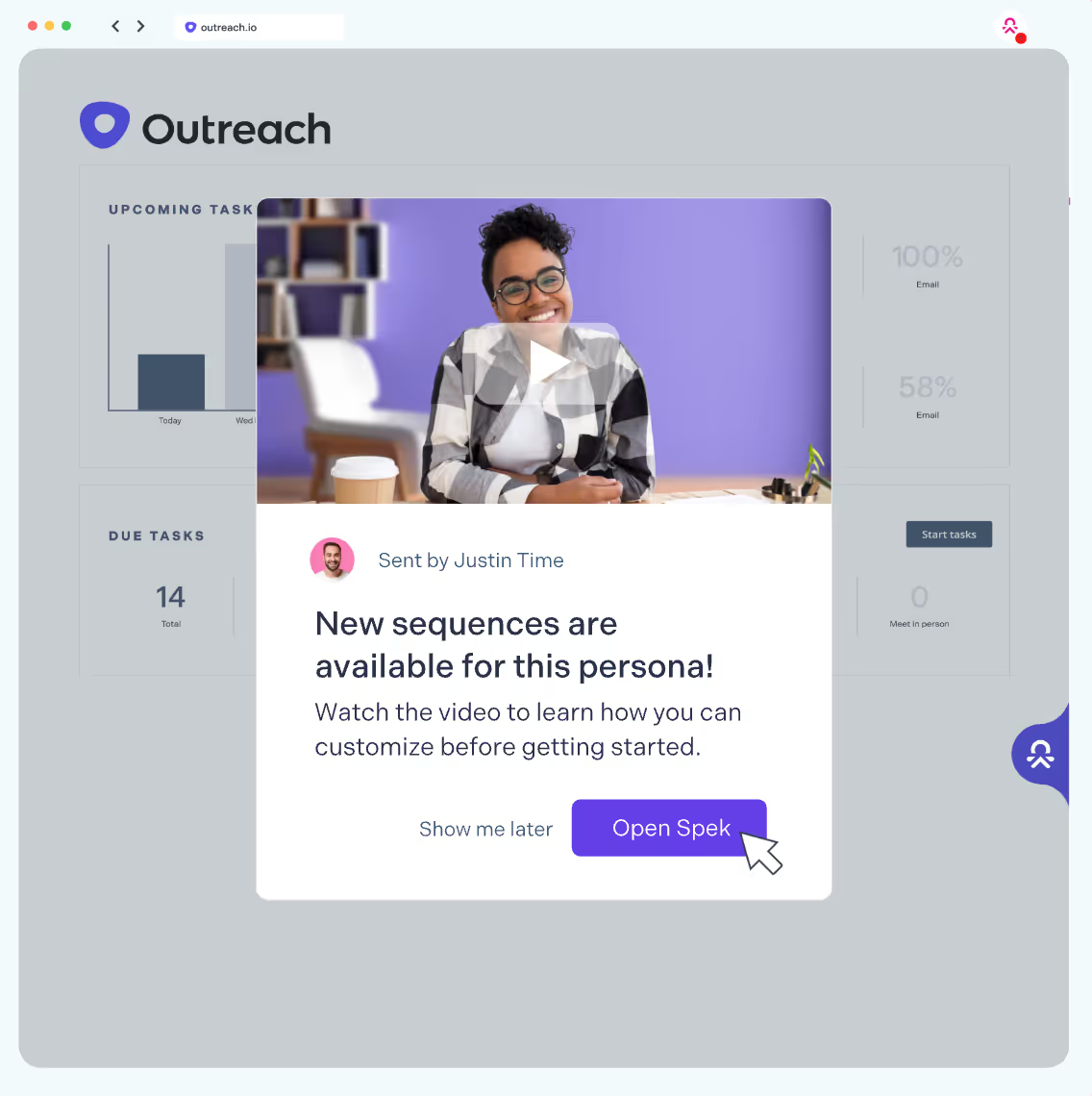
These real-time updates ensure every rep, across every team and tool, is working from the same, consistent source of truth.
4. Reinforcing key concepts through assessments.
Assessments help managers understand whether reps are actually absorbing the material and, more importantly, if they can apply it in real conversations with prospects.
With Spekit’s Knowledge Checks, you can easily set up simple assessments or quizzes to track your team’s progress and reinforce key concepts. These checks give you quick, actionable insights into whether the training content is landing or missing the mark.
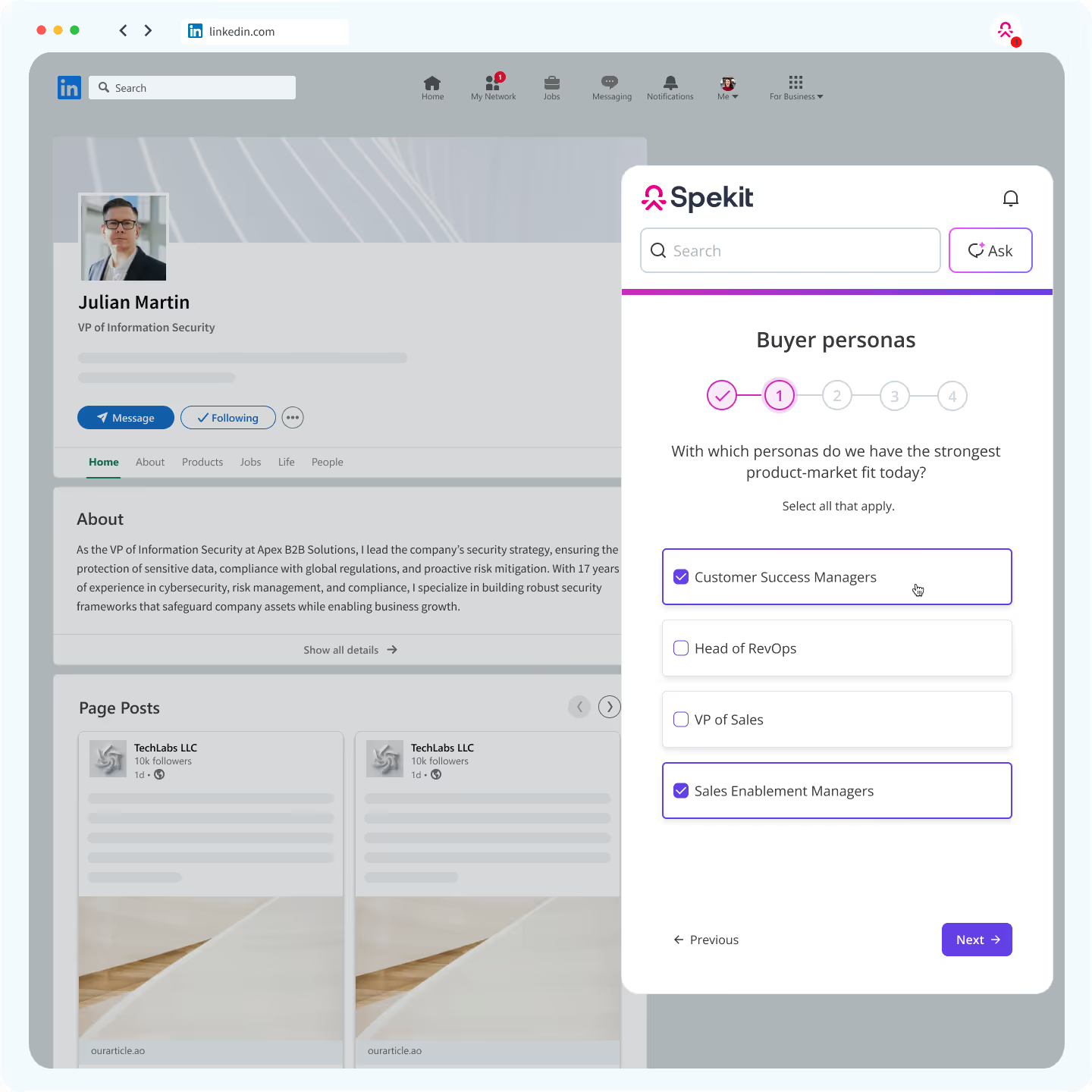
You’ll also get a dashboard showing who’s completed their Knowledge Checks, what they scored, and where they might be struggling. It’s an instant snapshot of your team’s strengths and gaps, so you know exactly where to follow up, who needs support, and what content to reinforce.
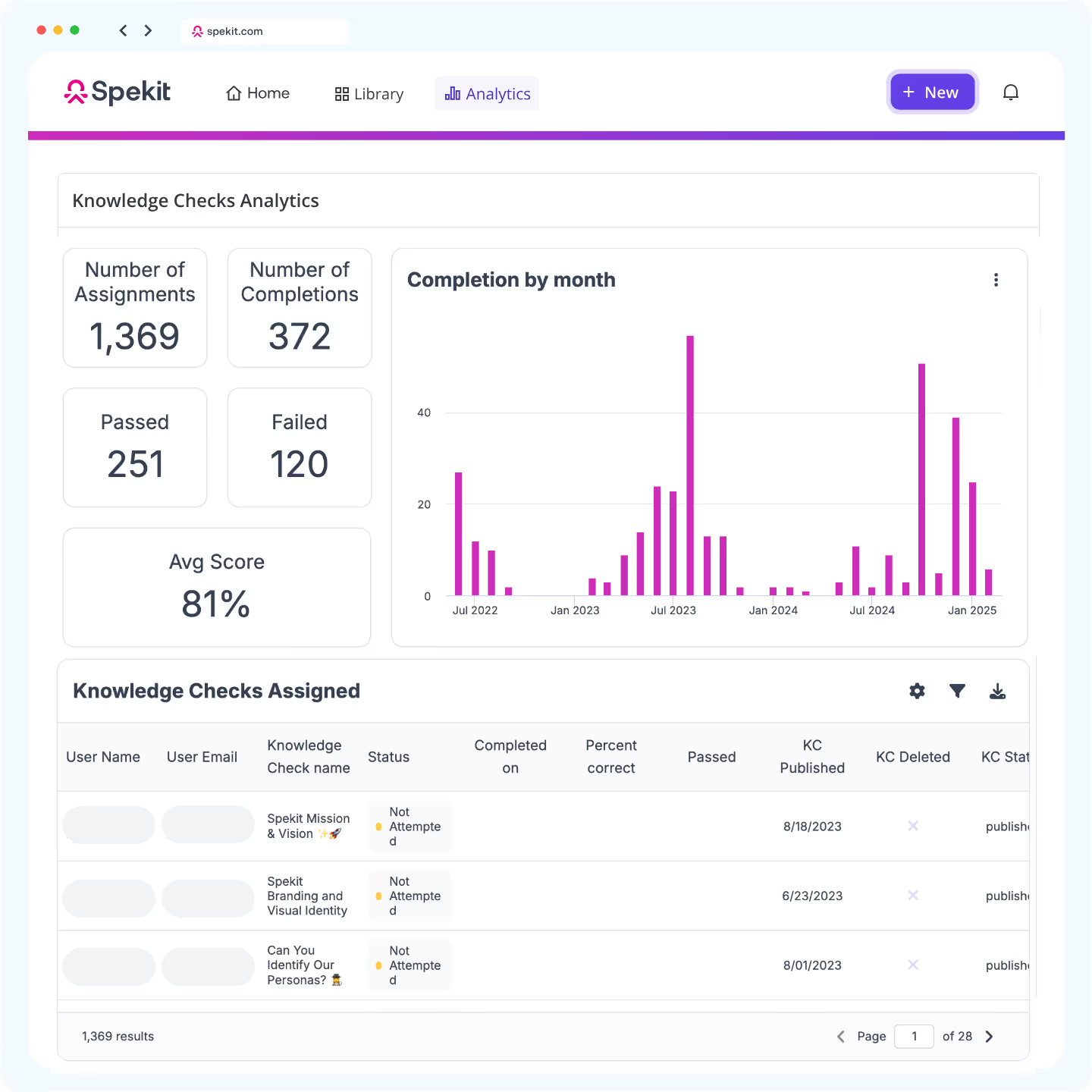
Measuring sales readiness for product launches
Just because reps completed training doesn’t mean they’re ready to sell. Without clear visibility into who’s confident, who’s struggling, and where the gaps are, it’s easy to miss signs that someone’s struggling, until deals start slipping.
Here’s how to measure sales readiness and use those insights to guide coaching.
Tools to measure sales readiness
To get a clear picture of how prepared your reps really are, here are some tools to use:
- Confidence surveys: Run short, anonymous pulse checks to ask reps how comfortable they feel with the messaging, pricing, objection handling, or demo flow. These surveys surface hesitation reps might not voice out loud.
- Content engagement: Track which reps are actually interacting with training content. If someone hasn’t touched the new battlecard or demo guide, they likely aren’t using it in conversations.
If you’re using Spekit, you get real-time insights into which resources are being viewed, ignored, or revisited, so you know what’s landing and what needs reinforcement (or adjument).
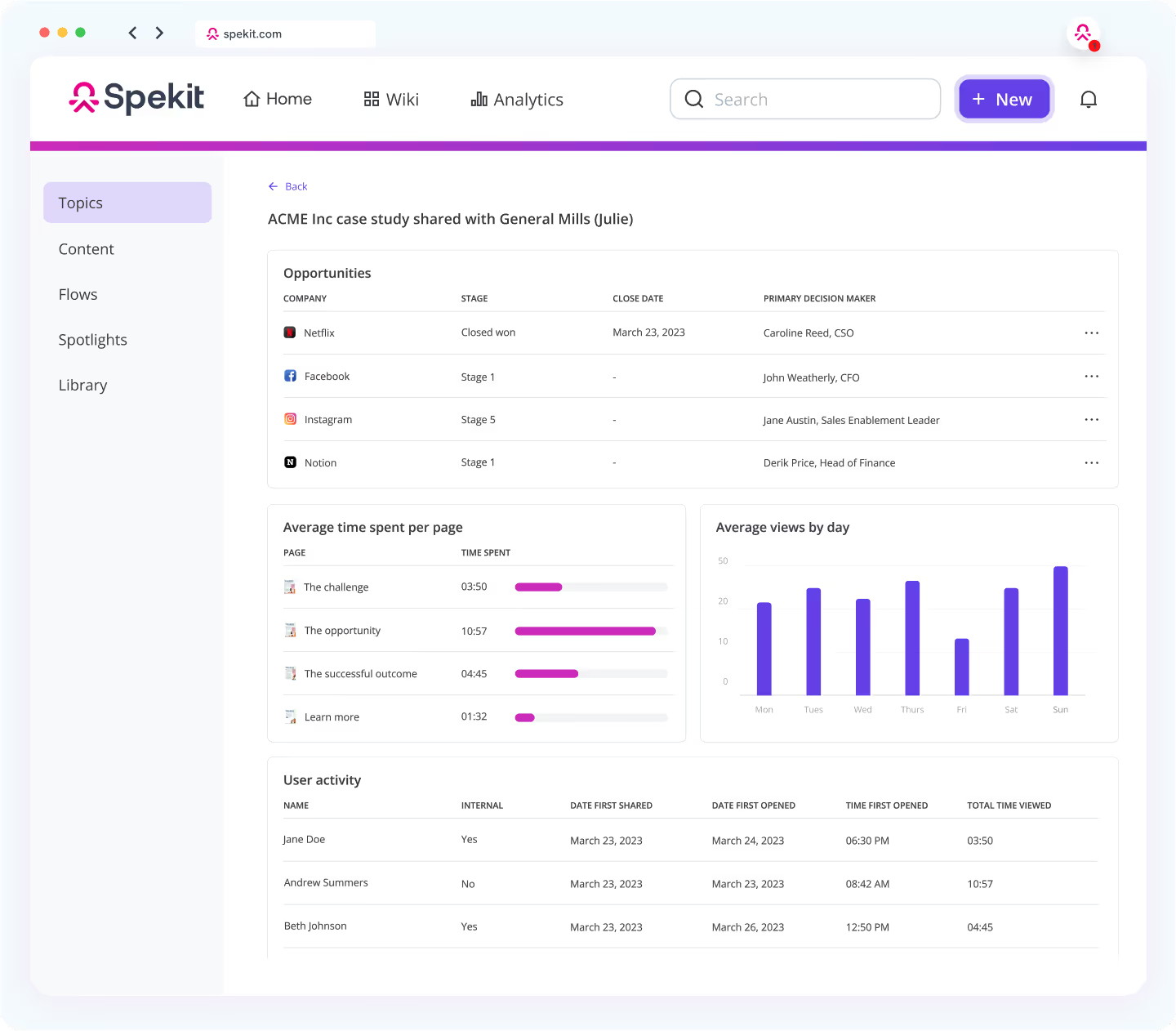
- Knowledge Checks: Spekit’s Knowledge Checks dashboard shows completion rates, scores, and trends across the team, so you can quickly spot knowledge gaps and compare readiness at both the individual and team level.
- Call analysis: Listening to real sales calls shows how well reps are translating training into action. Are they using the right language? Are they confident handling objections?
Call analysis tools like Gong or Chorus can help here, and paired with Spekit, you get a full picture of how sales enablement translates into performance.
- Manager assessments: In 1:1s, team huddles, and live calls, frontline managers can spot hesitation, confusion, or missed cues. Their observations add valuable context to the results from surveys and assessments.
How to spot coaching gaps early
Even with great content, not every rep will absorb or apply information the same way. To prevent surprises on live calls, keep an eye out for early signs of misalignment.:
You’ll need to look for:
- Mismatch between survey responses and behavior If a rep reports high confidence in a survey but stumbles during demos or misses key talking points, that’s a red flag. Dive into their recent call recordings or role-plays to spot the disconnect—do they understand the material but struggle to apply it under pressure?
- Low engagement with training content: Reps who rarely open training resources or skip Knowledge Checks likely aren’t retaining key information, like how to position the product, differentiate it from competitors, or tailor messaging to different personas. That disengagement often shows up later as long pauses, uncertainty, or stumbling through key points during sales conversations.
- Call patterns that don’t align with training: If reps are using the wrong messaging or fumbling through objections, it usually means they didn’t absorb the training or aren’t confident applying it. Reviewing their conversations can help you figure out if they’re unclear on the material or just need more practice delivering it.
- Manager observations: Encourage frontline managers to share concerns based on what they see in 1:1s, huddles, and live calls. They often spot issues, like repeated confusion, hesitation, or overreliance on slides, that don’t always show up in dashboards.
Turning insights into targeted enablement
Once you’ve identified readiness gaps, the next step is to act on them quickly and precisely.
If a rep struggles with objection handling, don’t rerun the full training. Instead, send a Spek (or document) that contains acceptable rebuttals to objections and helpful resources, like talk tracks and case studies.
If several reps are weak on pricing, schedule a focused session with the Product team to clarify the pricing details. And if someone is scoring low across Knowledge Checks, pair them with a top performer or schedule coaching around their specific blind spots.
Targeted follow-ups ensure reps get the right support, at the right time, without being overwhelmed with information they already know.
Read: How to Improve Sales Rep Performance (9 Strategies for 2025)
The new product sales training strategy you need starts with Spekit
Sales readiness doesn’t stop after launch day. As messaging evolves and new questions surface, your reps need just-in-time support right where they’re already working.
Spekit embeds training directly into the tools your team uses every day, so guidance is always accessible in the flow of work. You can roll out updates instantly, track engagement in real time, and ensure every rep is aligned with the latest messaging, pricing, and positioning information.
Whether it’s the first week of launch or the third month of scaling, Spekit gives enablement teams a simple, powerful way to reinforce knowledge, close gaps, and drive consistent execution across every conversation.
Want to learn how Spekit can help you? Book a demo today.

